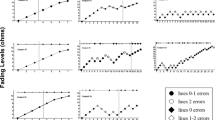Abstract
Twenty-four university students received differential Pavlovian conditioning with two colored stimuli separately accompanied by shock, and two other colored stimuli separately presented without shock. The reinforced and nonreinforced pairs of stimuli both contained complementary elements. After differentiation between the reinforced and nonreinforced elements was established, the complementary pairs were each additively mixed, (i.e., presented at the same time and in the same locus), producing two identical white compounds (established by pilot study). The subjects’ skin-conductance responses to the two compounds showed that their different conditioning histories did not result in different responses. Rather, a simple declining function was obtained, resembling habituation or extinction. It was concluded that the definition of the conditional stimulus as a physical event is inappropriate in studies in which physically different stimuli may result in identical internal processes (or phenomenologic experiences)—for example, in additive color mixture.
Similar content being viewed by others
References
De Valois, R. L. (1973) Central mechanisms of color vision. In Jung, R. (Ed).Central Processing of Visual Information A: Integrative Functions and Comparative Data. Berlin: Springer, pp. 209–253.
Gibson, J. J. (1933) Adaptation, after-effect, and contrast in the perception of curved lines.Journal of Experimental Psychology, 16, 1–31.
Gibson, J. J. (1967) On the proper meaning of the term “stimulus.”Psychological Review, 74, 533–534.
Gregory, R. L. (1974)Concepts and Mechanisms of Perception. London: Duckworth.
Grings, W. W., and Kimmel, H. D. (1959) Compound stimulus transfer for different sense modalities.Psychological Reports, 5, 253–260.
Grings, W. W., and O’Donnell, D. E. (1956) Magnitude of response to compounds of discriminated stimuli.Journal of Experimental Psychology, 52, 354–359.
Kimmel, H. D., King, J., Hudy, J. J., and Gardner, K. A. (1980) A mutual inductance shocker.Behavior, Research Methods and Instrumentation, 12, 605–606.
Lachnit, H., and Bohn, A. (1986) Pavlovian conditioning with proximal stimuli.The Pavlovian Journal of Biological Science, 21, 156–159.
Lykken, D. T. (1972) Range correction applied to heart rate and GSR data.Psychophysiology, 4, 437–442.
Lykken, D. T., and Venables, P. H. (1971) Direct measurement of skin conductance: A proposal for standardization.Psychophysiology, 4, 656–672.
Öhman, A. (1972) Factor analytically derived components of orienting, defensive, and conditioned behavior in electrodermal conditioning.Psychophysiology, 9, 199–209.
Pavlov, I. P. (1927)Conditioned Reflexes. Anrep G. V., (trans). Oxford: Oxford University Press.
Pavlov, I. P. (1953)Collected Works of I. P. Pavlov. Pickenhain, L. (trans). Berlin: Akademie Verlag.
Prokasy, W. F., and Kumpfer, K. L. (1973) Classical conditioning. In Prokasy, W. F., and Raskin, D. C. (Eds).Electrodermal Activity in Psychological Research. New York: Academic Prss, pp. 157–202.
Stern, J. A., and Walrath, L. C. (1977) Orienting response and conditioning of electrodermal responses.Psychophysiology, 14, 334–342.
Venables, P. H., and Christie, M. J. (1980). Electrodermal activity. In Martin, I., and Venables, P. H. (Eds).Techniques in Psychophysiology. Chichester: Wiley, pp. 4–67.
Author information
Authors and Affiliations
Rights and permissions
About this article
Cite this article
Lachnit, H., Pieper, W., Hilpert, A. et al. Pavlovian conditional stimuli cannot always be defined solely in physical terms. Pav. J. Biol. Sci. 23, 158–164 (1988). https://doi.org/10.1007/BF02700427
Issue Date:
DOI: https://doi.org/10.1007/BF02700427




